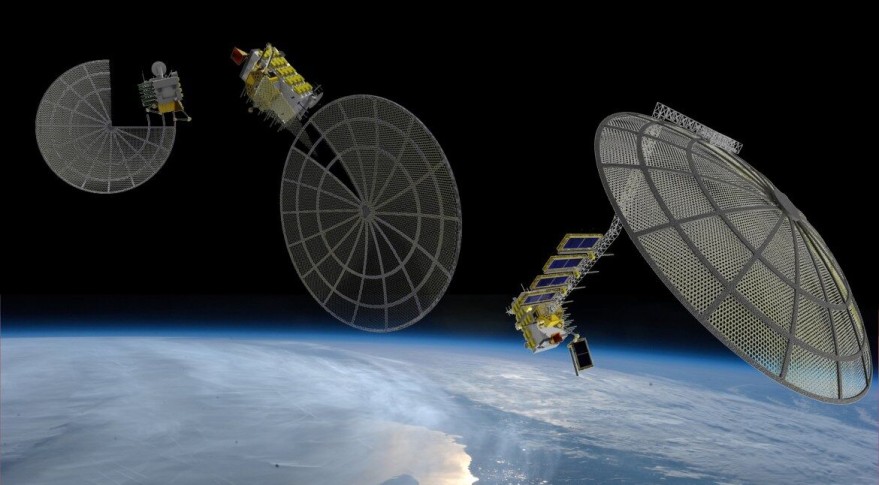NASA, Made in Space Think Big with Archinaut, a Robotic 3D-Printing Demo

MOFFETT FIELD, California — Within five years, companies could begin in-orbit manufacturing and assembly of communications satellite reflectors or other large structures, according to Made in Space, the Silicon Valley startup that sent the first 3D printer to the International Space Station in 2014.
As Made in Space prepares to send a second 3D printer into orbit, the company is beginning work with Northrop Grumman and Oceaneering Space Systems on Archinaut, an ambitious effort to build a 3D printer equipped with a robotic arm that the team plans to install in an external space station pod, under a two-year, $20 million NASA contract. The project will culminate in 2018 with an on-orbit demonstration of Archinaut's ability to additively manufacture and assemble a large, complex structure, said Andrew Rush, Made in Space president.
NASA's selected the Archinaut project, officially known as Versatile In-Space Robotic Precision Manufacturing and Assembly System, as part of its Tipping Points campaign, which funds demonstrations of space-related technologies on the verge of offering significant payoffs for government and commercial applications. Archinaut was one of three projects NASA selected in November that focus on robotic manufacturing and assembly of spacecraft and structures in orbit. [3D Printing in Space: A Photo Gallery]
"We are attempting to change the way we build space systems," Steve Jurcyk, associate administrator for NASA's Space Technology Mission Directorate, said Feb. 19 during a press briefing at Made in Space's office in the NASA Ames Research Park, Moffett Field, California. "Now, we build things on the ground and launch them using fairly expensive and complicated rockets. We are seeking to create an infrastructure to build systems in space rather than launching them."
That type of infrastructure would enable NASA and private space companies to launch the raw materials used in additive manufacturing along with certain high-value components like sensors, electronics and batteries. Once in orbit, robotic arms would mate the parts sent from Earth with additively manufactured elements, said Howard Eller, chief architect for advanced concepts at Northrop Grumman Aerospace Systems.
If on-orbit manufacturing and assembly are possible, they could revolutionize spacecraft design because engineers would no longer need to create structures capable of withstanding the force of Earth's gravity before they launch, fitting inside a rocket fairing or withstanding the vibration and acoustic forces of launch, Jurcyk said.
Archinaut is a first step on that path. Made in Space is building Archinaut's 3D printer, which it plans to mate with a manipulator arm built by Oceaneering Space Systems. Northrop Grumman is providing systems engineering, control electronics, software, testing and assistance with Archinaut's space station interface.
Get the Space.com Newsletter
Breaking space news, the latest updates on rocket launches, skywatching events and more!
If tests in 2018 prove Archinaut performs as intended, Made in Space and its partners hope to continue the project by enlarging the additive manufacturing element and equipping it with additional robotic arms. Eventually, the companies envision a version of Archinaut with three robotic arms capable of latching onto orbiting structures to add or remove components, which eventually would enable companies to remove parts from decommissioned spacecraft and use the parts in new spacecraft, Eller said.
That scenario offers the added benefit of cleaning up debris. "The problem with debris is that no one has an economic incentive to get rid of the stuff," Eller said. "If you can reuse the parts, there is an economic incentive because it costs $100 million to get all the stuff up there in the first place."
This story was provided by SpaceNews, dedicated to covering all aspects of the space industry.
Join our Space Forums to keep talking space on the latest missions, night sky and more! And if you have a news tip, correction or comment, let us know at: community@space.com.
Debra Werner is a correspondent for SpaceNews based in San Francisco. She earned a bachelor’s degree in communications from the University of California, Berkeley, and a master’s degree in journalism from Northwestern University. Debra is a recipient of the 1989 Gerald Ford Prize for Distinguished Reporting on National Defense. Her SN Commercial Drive newsletter is sent out on Wednesdays.

